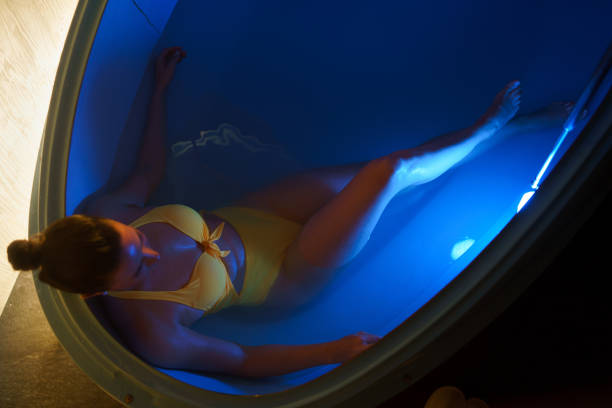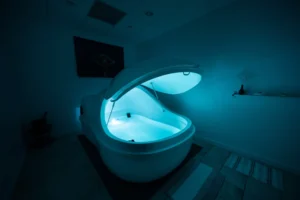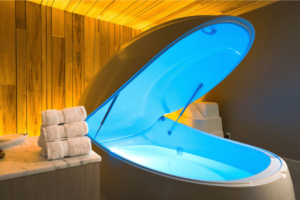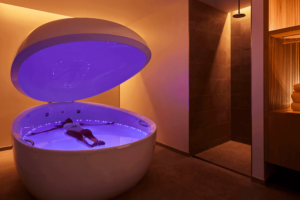Floating inside a quiet, water-filled tank may seem unusual at first, but many people in the United States are now choosing this practice to relax, recharge, and improve focus. A float therapy session is not just about shutting off the outside world; it is about creating space for your body and mind to reset.
If you are a small business owner carrying daily stress, a marketing manager searching for fresh ideas, or simply someone looking for peace, knowing how to make the most of your float can make your experience more rewarding.
This guide explains what float therapy is, how to prepare, what to do during your session, and how to carry the benefits into your daily life.
What Happens in a Float Therapy Session?
A float therapy session usually takes place inside a sensory deprivation tank, sometimes called an isolation tank. The tank is filled with warm water and large amounts of Epsom salt, making your body float without effort. The room is dark and quiet, free from outside noise and distractions.
According to the Float Tank Association, floating can help the mind and body relax more deeply, reduce stress, and support recovery. Many people seek it for the effects of float therapy such as less anxiety, better sleep, and relief from aches or muscle strain.
How to Prepare Before Floating
Preparation is one of the most important steps to make your session more effective. Think of it like a personal appointment where your only focus is yourself.
Avoid stimulants like coffee or energy drinks for a couple of hours before your float. Heavy meals can also make you uncomfortable inside the tank.
Arrive early to settle down. Going straight from a stressful drive into the tank may make it harder to relax.
Drop expectations about what you should feel. Some sessions bring deep calm, while others feel more like gentle rest. Both are valuable.
Making the Most of Your Time in the Tank
Once inside the float tank, simple choices can improve your experience.
Find a comfortable position. Some people like resting their arms above their head, while others prefer them at the sides. Let your body guide you.
Focus on your breathing. If your mind is busy, pay attention to slow, steady breaths. This helps you relax and can lead to a more meditative state.
Trust the water. The salt keeps you afloat, so there is no need to hold tension in your body. Let your shoulders and neck loosen fully.
Use the tools provided. Earplugs or a small neck pillow can make the session more comfortable and help you stay focused on the experience.
The Benefits of Sensory Deprivation Float Tanks
Floating is not only about relaxation. It has a wide range of advantages that can improve both health and productivity. Some of the most common benefits of sensory deprivation float tanks include improved sleep, reduced anxiety, faster recovery for sore muscles, sharper focus, more creativity, and relief from ongoing pain or migraines.
For busy professionals in the United States, these effects of float therapy often translate into clearer thinking, better energy, and improved problem-solving skills.
What to Do After Your Float Therapy Session
Stepping out of the tank is not the end of the experience. The way you spend the next hour can make the benefits last longer.
Drink water to re-balance your body.
Write down your thoughts. Many people notice creative ideas or solutions during floating. Keeping a short journal helps capture these insights.
Do light movement such as stretching or walking to let your body adjust.
Give yourself time before jumping back into a demanding schedule. This way, the feeling of calm stays with you longer.
Mistakes to Avoid During Float Therapy
There are a few things that can prevent you from fully enjoying the experience. Checking your phone right before or after floating interrupts your mental calm. Eating too much before a session may make you uncomfortable. Expecting one specific result can leave you disappointed, so stay open to whatever happens. Ignoring post-session reflection means you might miss valuable insights.
Helpful Tips for First-Time Floaters
If this is your first float therapy session, keep a few things in mind. Wear comfortable clothes for after your float. Do not shave or wax right before since the salty water can sting. If darkness feels intimidating, many tanks allow you to keep a soft light on. Begin with a 60-minute session and then try longer floats once you feel more comfortable.
Who Benefits Most from Float Therapy?
Float therapy has something to offer everyone, but it can be especially helpful for certain groups.
Small business owners can recharge and manage stress more effectively.
Marketing managers and directors often find more creativity and clearer ideas after floating.
E-commerce professionals may feel relief from constant screen time and mental fatigue.
Local businesses in the United States can even consider offering float therapy sessions as part of employee wellness programs.
The effects of float therapy go far beyond personal relaxation. They can support healthier, more focused workplaces as well.
Final Thoughts
A float therapy session is more than just lying in water. It is a chance to reset both mind and body. With the right preparation, mindful breathing, and attention after the session, you can get the best out of every float.
For those who want expert support, Secret Soak Society is an excellent choice. They guide people through the floating process, help set clear expectations, and ensure the experience is enjoyable and effective. For anyone wanting more focus, balance, and peace of mind, their guidance makes floating even more rewarding.
Frequently Asked Questions
How long should my float therapy session last?
Most people start with 60 minutes. Longer sessions of 90 minutes can bring deeper relaxation.
Is float therapy safe?
Yes. The tanks are cleaned thoroughly, and the saltwater naturally keeps bacteria from growing.
Will I feel trapped or claustrophobic?
You can leave the door open or choose a larger float pool if that makes you more comfortable.
How many sessions are needed to notice results?
Some people feel benefits right away. Others choose weekly or biweekly floats for ongoing improvements.
Do I need to bring anything?
Most float centers provide towels, shampoo, and earplugs. You only need to bring comfortable clothes afterward.





